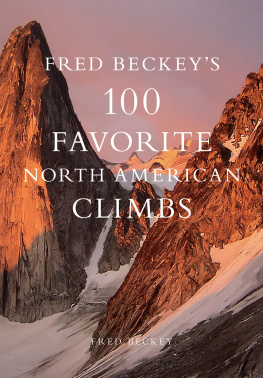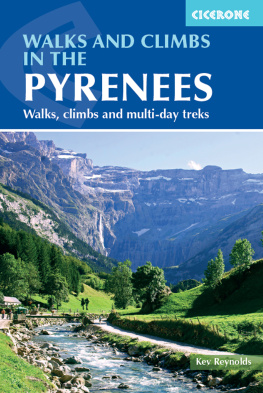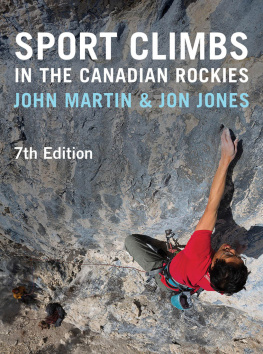Foreword
We live on an astounding planet, punctuated by mountains on every continent. The mere presence of mountain ranges has long drawn the human imagination as an invisible force. Some say mountains have a psychic gravity enticing us into their grip. There is a magic among great peaks as a location of splendor, where changing light plays games with intense colors, affecting the tones of snow and ice and many gleaming ridge outlines.
Mountain peaks have long filled humanity with a sense of the supernatural, and in ancient times were holy places, and in some cultures were considered sacred the abode of the great spirit. In Asia, millions of the devout regard the Himalaya as the dwelling place of gods and a pathway to the heavens. Certainly the potentially dangerous nature of such mountains has tightened their grip on the human imagination.
Climbing teaches us persistence and courage, while building confidence. When an ascent has gone well, it can bring an intense feeling of satisfaction, but a precarious ascent can bring fear. We may need to make meaningful decisions rapidly and a commitment to continue or descend. Strategy may be more important than strength, endurance, or quickness. The addition of risk brings out a special alertness one similar to hunting a dangerous beast. As David Roberts has pointed out in The Mountain of My Fear, without risk, climbing would be just another game.
Climbing is never wholly predictable, and from this uncertainty a richness may arise. It is important not to diminish the spirit of climbing and eliminate all risk. To reduce all commitment lessens the spirit and engagement of the adventure.
The British climber Al Alvarez wrote about the pleasure of risk and how climbing brings out alertness. When a climb has gone well, it is an intense sense of physical well-being, he wrote. Climbing is a paradoxical intellectual pastime . Each pitch becomes a series of specific local problems . Each move has to be worked out by a kind of physical strategy, in terms of effort, balance, and consequences.
To reduce the chance of an accident, competent climbers develop a balanced relationship with fear, an awareness of danger, and turn their mental energy into positive means to overcome problems. Both instinct and acquired judgment are developed from experience. One learns about choices, when to push limits, where to avoid stonefall, where to belay, and when to turn back.
While the Alps were long feared and considered to be the home of dragons, demons, and evil spirits, these negative thoughts diminished when English gentlemen became alpine tourists in the mid-18th century. In 1786, Mont Blanc was climbed, and soon after, men of distinction stirred a dismissal of fear and dislike of high peaks. A passion for climbing certainly influenced Edward Whymper, who became enamored with the Swiss Alps in 1860, and five years later led his party up the Matterhorn.
Another Briton, James Outram, later came under the spell of the Canadian Rockies. He exulted, There is a wonderful fascination about mountains. Their massive grandeur splendour of striking outline when giving reasons to scale the heights. Many have attempted to explain this vexing question one that defies rational explanation and so George Mallorys reply, Because they are there became a clich for the public. The simple joys and thrills of climbing, and its risks and commitments, were given an explanation by Guido Rey in Peaks & Precipices: Scrambles in the Dolomites & Savoy published in 1914.
This was my first climb of the year, and as I was experiencing again in all its perfection the joy of alpine life, a joy unparalleled, pervading body and soul, different from all other human joys, compounded of countless almost indefinable sensations sensations begotten of changing scenes, the lightness of the air, the solitude which is about us and the peace which is within us; of the sense of height, the expectation of danger, the thrill of freedom .
Growing up in the Pacific Northwest, the craggy peaks of two mountain ranges were often visible, and their impressive outlines caught my interest. At a youthful age I became fascinated by landscapes, and also learned to finesse the conflicting demands of wild nature for a certain freedom from convention, as embodied in conservative parents and their friends. As a Boy Scout in Seattle I participated in forest and mountain hikes, where I became enamored with the wilderness. Here I found an addiction, camaraderie, scenic rewards, and a great outlet for energy.
My epiphany was the ascent, with a Boy Scout troop, of Mt. Olympus in Washington, where I became more aware of the ceaseless interplay of earth-shaping forces and the techniques of ascending a shining, crevassed glacier. Another of my first wilderness experiences was an ascent of Mt. Triumph, an isolated rock horn in the North Cascades. While standing on the summit and surveying the surroundings with a sense of awe, I felt a kinship with the noble, almost unbelievable peaks and tumbling glaciers.
As I became consumed with mountaineering puzzles, I found an opportunity to make my own decisions that lasted far beyond the boundaries of team sports. I discovered that climbing required making meaningful decisions, practicing the facets of strategy, and a commitment difficult to equal in daily life. There was a freedom from constraints, and an intensity and happiness after a safe return. In particular, the summer of 1940 and 1941 brought challenging first ascents in the Cascade Range ones that developed self-reliance, perseverance, responsibility, and had a seductive effect. Success, ambition, and an insatiable curiosity about greater ranges spurred my quest to undertake a six-week expedition in 1942 to Mt. Waddington in Canada, where my brother and I found our expectations almost exceeded our brief backgrounds. In time, we became comfortable with our isolation. Very likely we were considered to be eccentric nonconformist teenagers yet creative with planning and technical advances.
The Alaska Panhandles stellar peaks became my next alpine obsession, one combining a creative approach to climb Kates Needle and Devils Thumb, which I made with Bob Craig and Cliff Schmidtke in 1946. Our victories were narrow, but led to more optimism. During the following summer I joined a large team with the fixed purpose of climbing remote unclimbed peaks in the British Columbia Coast Mountains east of Mt. Waddington. Mt. Asperity was our zenith, but an avalanche on Serra II brought a fatality and nearly ended my existence. Successive expeditions to the Juneau Icefield were productive, with skiing traverses that led to new technical ascents.
The Alaska Range beckoned in 1954, my adventures beginning with a new route on Mt. McKinley, to be followed by success on unclimbed and dangerous Mts. Deborah and Hunter with Heinrich Harrer and Henry Meybohm. Continuing mountaineering expeditions to numerous Alaskan mountains resulted in rewarding exploratory ventures. Yet the Cascade Range, Sierra Nevada, Wind River Mountains, Canadian Rockies, Bugaboos, and Coast Mountains also lured me into productive challenges. In a quite different arena, the Southwest desert brought both frustrations and triumphs on Shiprock, the Great White Throne, and numerous unclimbed freestanding monoliths.
The majesty, allure, and history of a cherished selection of peaks and routes in North America are portrayed in 100 Hundred Favorite Climbs. The choices range among ascents that have given me a special sense of satisfaction and accomplishment; climbs with aesthetic appeal, climbs with a range of difficulty, and what the pundits have touted.
The descriptions between the covers of this book include climbing history, the geographical setting, occasional anecdotes, and a summary of advice. I have attempted to avoid the typically terse imperatives of guidebook prose, but have included vital access and route details. Despite the assistance of photographs, descriptions, maps, and topos, finding a way among the many puzzling features of a complicated route or alpine peak may still be a serious challenge, with possible penalties arising from poor judgment and lack of competence.






